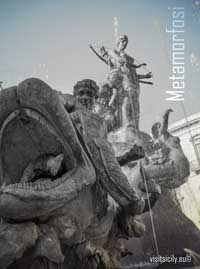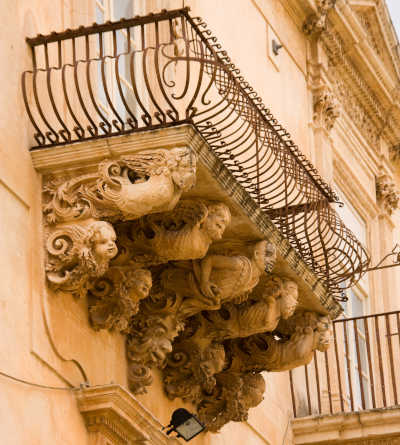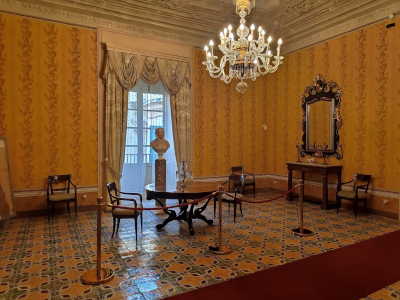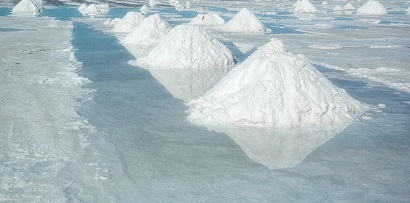
Perchè visitarlo:
Palazzo Nicolaci dei Principi di Villadorata è un simbolo che oggi, riportato
agli antichi splendori, dà la dimensione della ricchezza artistica e
dell’opulenza del centro netino, in un periodo ormai passato.

10:00 - 19:00 7/7
Aggiornamento orari
€ 4, ridotto € 2
Residenza nobiliare urbana della famiglia Nicolaci, in pieno stile barocco, questo edificio progettato da Rosario Gagliardi conta ben 90 ambienti.
Il Palazzo, quale appare oggi ai nostri occhi, fu voluto e iniziato da Giacomo Nicolaci, uomo di grande intelletto e cultura, amante dell'arte e del "bello".
I balconi pare riprendano quelli del Palazzo del Barone di Trezzano a Noto antica. Fra i mensoloni che li reggono, la figura chiave è quella al centro del terzo balcone da sinistra, l’uomo con il flauto, che incarna una frase del testamento di Giacomo: “Nulla giova all’anima esser dotto, se nello stesso tempo non è Santo”.
L’ala principale di Palazzo Nicolaci è stata acquistata dal Comune di Noto nel 1983 ed è stato completamente recuperato grazie ad una serie di restauri operati dalla Soprintendenza ai Beni Culturali di Siracusa, sotto la guida dell’architetto Giovanna Susan.
La facciata è caratterizzata da un ampio portale fiancheggiato da due grandi colonne ioniche e sormontato da una balconata in pieno stile barocco.

Ai lati troviamo una sequenza di balconi delle inferriate in ferro ricurvo, sorretti da mensoloni in pietra scolpita con le sembianze di figure grottesche quali sirene, leoni, sfingi, ippogrifi, cavalli alati e angeli.
I balconi pare riprendano quelli del Palazzo del Barone di Trezzano a Noto antica. Fra i mensoloni che li reggono, la figura chiave è quella al centro del terzo balcone da sinistra, l’uomo con il flauto, che incarna una frase del testamento di Giacomo: “Nulla giova all’anima esser dotto, se nello stesso tempo non è Santo”.
La costruzione si articola su quattro piani: il pianterreno, il piano “dammusato”, era destinato alle scuderie ed ai magazzini per le scorte di generi alimentari; il primo piano detto “mediastino”, era l’abitazione del barone Giacomo; il piano superiore era adibito a residenza nobile dei familiari; l’ultimo piano, il sottotetto, era destinato alla servitù.
DA NON PERDERE: visita del Piano Nobile e i suoi ambienti

L’elegante scala ottocentesca di stile Neoclassico, con stucchi che simulano il marmo, vi condurrà al piano nobile.
Un corridoio vi porterà alla prima sala, la “Sala del Tè”, decorata con motivi orientali e dove noterete due intriganti figure cinesi.
Si passa quindi al Salone delle Feste, con decorazioni “Trompe I’oeil” che simula una balaustra sovrastata da colonne laterali sulle pareti. Al centro del soffitto troviamo invece l’allegoria del Carro di Apollo che insegue l’Aurora, una copia dell’originale di Guido Reni.
Dal salone delle feste si passa ad una successione di saloni finemente arredati con mobili ottocenteschi provenienti da varie parti d’Europa. Non sono purtroppo i mobili “originali” usati dalla famiglia Nicolaci, ma la scelta degli arredi di ogni ambiente suggerisce le attività e le atmosfere che animavano questi ambienti fino agli ultimi anni del Novecento.
Un’ala del Palazzo Nicolaci accoglie oggi la Biblioteca Comunale, fondata nel 1817, ricca di migliaia di volumi e manoscritti latini e spagnoli a cui va aggiunta una galleria di ritratti degli uomini illustri di Noto, dono del barone Astuto.



















 |
Airone cenerino (Foto: Ómar-Runólfsson) |
 |
Tuffetto |
 |
Svasso (Foto: Marek-Szczepanek) |
 |
Pettegola (Foto: Andreas-Trepte) |
 |
Moretta tabaccata (Foto: Erbanor) |
 |
Garzetta (Foto: Andreas-Trepte) |
 |
Fenicotteri rosa (Foto: Estormiz) |
 |
Avocetta (Foto: Erbanor) |
 |
Azavola (Foto: Steve-Garvie) |



